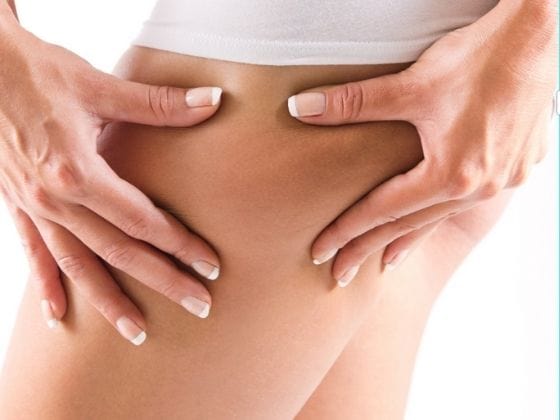Fascia is a sheet of webbed tissue, made up of mostly collagen, located beneath your skin that attaches and encloses your muscles and other internal organs.
It helps your body move with ease while connecting your organs to your ribs to your muscles and all your bones to each other.
Fascia holds your entire body together!
You know when you eat a steak, and you go to pull apart the meat and you see that thin layer of ... something, holding together the two pieces? THAT is fascia.
What Does Fascia Do?
Fascia plays a major role in every movement you make and even every injury you've ever had.
It creates a strong, slippery sheath, wrapping around each of your internal parts; muscles, bones, organs, separating and allowing movement in your body.
It's able to act independently of the muscles it surrounds and responds to your stress unconsciously.
Many people hold stress in their muscles, causing the muscles to become stiff and inflexible.
The stress triggers the fascia to thicken around the muscles in an attempt to protect the underlying muscles which in turn causes; constricted muscles and decreases blood supply, causing pain and decreased range of motion.
Imagine your fascia as an elastic bodysuit, encasing your whole body.When you pull up on the shoulder part of the suit, it doesn't just tug on the shoulder, right? The entire suit responds; The shoulder tugs on the back which tugs on the hips which then tugs on the legs which tug on the feet.
You get the idea.
Now hold that part of your shoulder for 8 hours (that's about the time you spend hovering over your computer and steering wheel) ... the suit will be stretched out and fit awkward now.

Now imagine the bodysuit is your body with your fascia bent all out of shape and pulled in awkward ways like the suit. OUCH Doesn't sound comfortable.
But that's how we treat our fascia pretty much every day without even realizing it.
You know that recurring injury you have? The annoying one that just seems to come and go whenever it pleases and you can't seem to figure out how to get rid of it?

I bet fascia has something to do with it.
But don't worry, any sort of damage you've caused your fascia is reversible and can also be avoided with proper fascia care.
What Causes Unhealthy Fascia?
Lack of activity:
Lack of movement will cause a build-up of immobile fascia, resulting in stiffness and reduced elasticity.
Chronic stress:
Remember, stress causes the fascia fibers to thicken in order to protect the underlying muscles.
Poor posture, Lack of Flexibility and Repetitive Movements:
All three of these cause the fascial webbing to be pulled into ingrained patterns. These behaviors act as a "snag" like in a sweater; easy to form, hard to properly get rid of. Any sort of bad habit is a bit difficult to get rid of, especially when it comes to the formation of your body tissue.

Ways to Improve Your Fascia Health at Home
Move your body:
Fascial surfaces that aren't regularly moved get sticky and can create a strong bond with one another, inhibiting your range of motion. Great news! Moving and stretching is a buildable habit. First thing in the morning, remember to stretch before getting out of bed as part of your routine.
If you are at your office or desk, raise your arms and stretch your shoulders. Take a walk every 30 minutes or so to loosen and move your body.

Hydrate!
Fascia is a wet and slippery coating that wraps around all of your organs, muscles and bones, remember? So keep it wet! Your fascia tissue is made up of water, so drink, drink DRINK! Drinking plenty of water will keep your fascia hydrated and move better.
Use a Foam Roller:
Foam rollers aren't just a great tool for your muscles, they help with your fascia too! Foam rollers help break up the tension you may have. When you find an area of tension, apply gentle pressure to that spot with your roller, and hold for 3 to 5 minutes.
Relax:
Take a warm bath, you deserve it! Fifteen to 20 minutes in a bath with Epsom salt can help relax your fascia and lose the tension in your muscles. Try to stay moving for at least 10 minutes after your bath to keep your blood circulating.
Get a Fascia Massage
Some fascia massages are similar to regular tissue massages while other methods focus more on stretching, like that of a Thai massage. Picking the right kind of massage for you is important. Whether you have an injury you need to help heal, or you're just looking for an increase in flexibility, it's important to pick a massage that matches your comfort level.

Rolfing:
Rolfing is a more aggressive approach to a fascial massage. This method focuses on manipulating the soft tissue to improve posture and alignment.
Fascial Unwinding:
During this process, the therapist focuses on areas that feel stiff and fixed, instead of elastic, unable to move under light manual pressure. Loosening these areas will release the tension around your muscles which can be the cause of your chronic pain.
If you feel like your fascia may be the cause of your aches and pains, try some stretching and movements at home and talk to a massage therapist who knows about fascial massages. You may need to “shop” around, but the benefits of getting a fascia massage can be TREMENDOUS.

Links:
- https://www.healthline.com/health/fascia#10-fascia-treatments
- https://www.painscience.com/articles/does-fascia-matter.php
- https://www.runnersworld.com/advanced/a20784481/understanding-your-fascia/
- https://www.mayoclinic.org/diseases-conditions/back-pain/expert-answers/myofascial-release/faq-20058136














